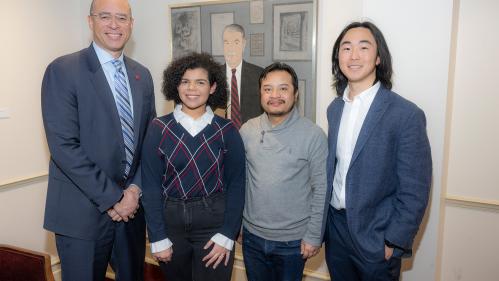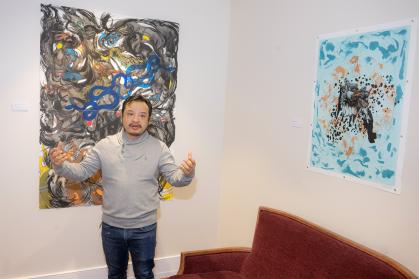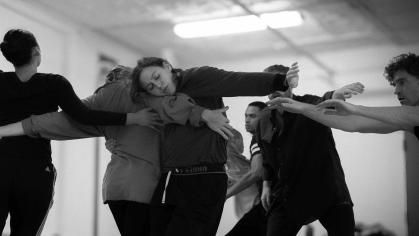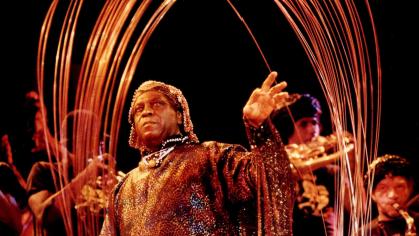Printmaking Helps Rutgers Graduate Student Heal From Traumatic Events

Kabi Lama has twice experienced international natural disasters. He joins other Mason Gross students whose artwork hangs in the president’s office suite
Kabi Lama’s ink drawing and mixed media work “Manjushree Hand & Sword” is a bold and chaotic depiction of the creation of Nepal’s Kathmandu Valley, inspired by Buddhist scripture. As the story goes, Lama says, the deity slashed through the mountains with his flaming sword, opening a gorge that drains a great lake and allowing a new habitat to emerge.
Lama’s artwork is influenced by what he calls the “mystical interplay between destruction and construction,” two opposites he is intimately familiar with as the survivor of two devastating natural phenomena.
In 2011, studying printmaking in Japan, Lama experienced the tsunami that claimed the lives of over 18,000 people. Then, in 2015, after returning home to Nepal, Lama lived through the earthquake that struck near Kathmandu, in which 9,000 people perished.
After these disasters, Lama refocused his artmaking as a medium for healing and a means to soften traumatic memories of the events. As a printmaker, Lama finds he can temper those haunting thoughts through the process of lithography in particular.
“It allows me to draw freely, and when I draw on stone and print on paper, it’s always a memory on the plate,” says Lama, who will graduate from Mason Gross School of the Arts this May with an MFA in visual art. “Printmaking has great potential on transferring memory and reality. The whole process of plate making and the excitement of pulling the print is a healing process that I enjoy a lot.”

Lama’s work now hangs in the office suite of President Jonathan Holloway at Winants Hall, along with work by art and design BFA seniors Beatryz Mendes and Henry Wang.
All three students were honored at a reception on February 21, where they had a chance to speak about their work and meet with President Holloway.
“We are so proud to have these pieces on display,” President Holloway remarked. “Featuring the remarkable work of Beatryz, Henry, and Kabi here at Winants not only celebrates their individual brilliance and vision but also offers a glimpse at the depth of talent across Rutgers’ student body.”
Lama is grateful to share his work—and its inspiration—with viewers from different backgrounds.
“It's such a great honor and opportunity to exhibit the work at…such a special place,” says Lama. “As an artist, I feel proud that the issues I bring in my artwork and the motive[s] from different cultures…will [be given] a wider audience.”
Lama has even collaborated with a neuroscientist at MIT to explore the healing effects of artmaking. Since meeting in 2018, the two have done experimental work that involves tracking the subtle movements of Lama’s eyes, hands, and head as he creates art, with the goal of understanding the internal processes of creativity and the correlation of the subjective feeling of epiphany, Lama explains.
During the experiments, Lama is monitored with multiple cameras while the data is processed by state-of-the-art machine-learning algorithms.
But for Lama, the proof of the power of art is self-evident.
“I get deeply involved in the drawing process, which is really a meditative moment for me,” says Lama. “The process itself is the healing process for me.”




